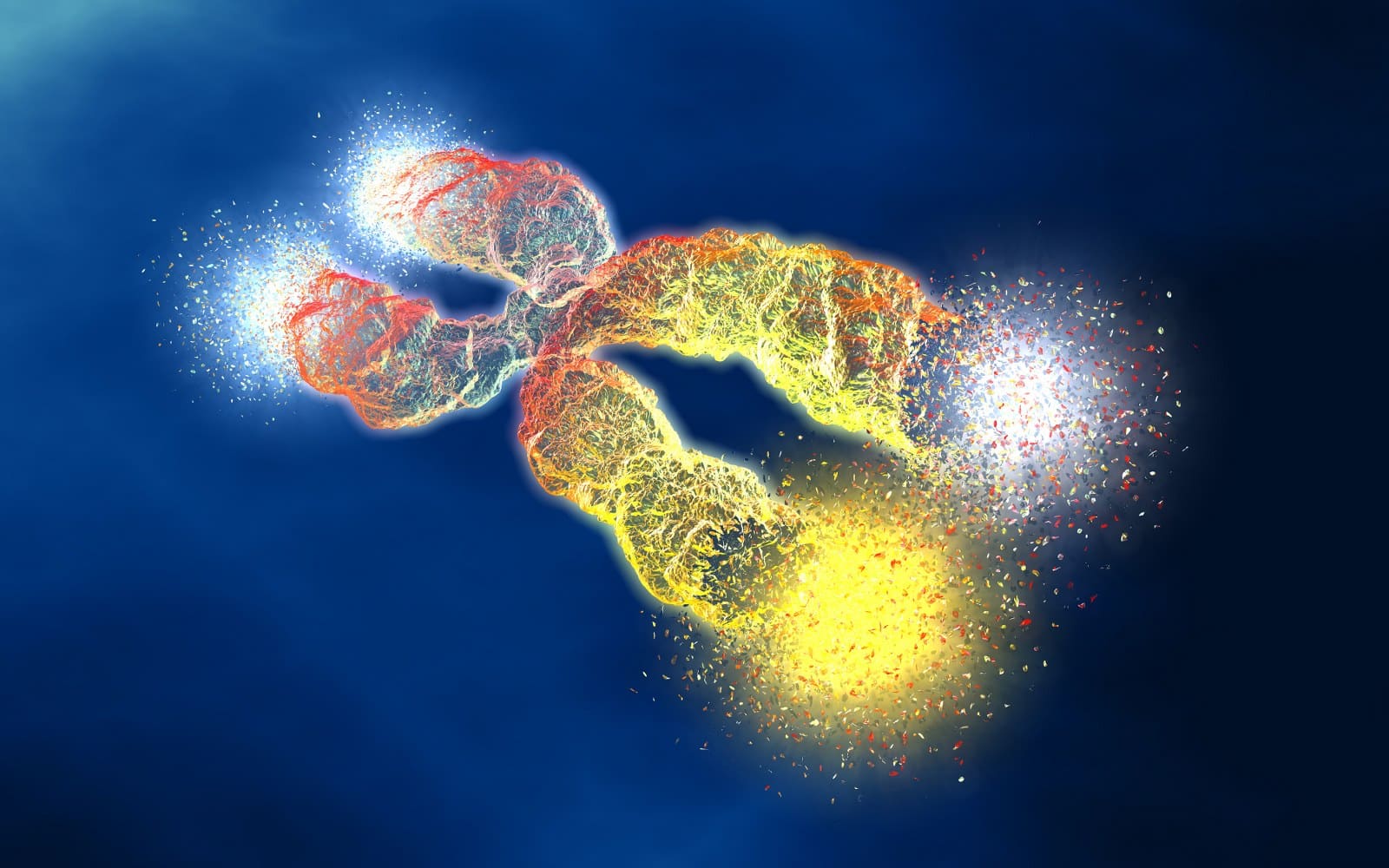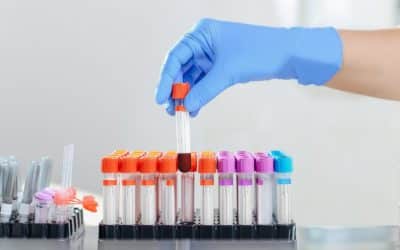
Telomeres are the “caps” on our DNA which protect our DNA. Just like shoestrings have plastic caps to protect them from unraveling, our DNA strands have telomeres that protect them against unraveling.
Telomeres are made of DNA themselves. But this DNA does not code for proteins.
The problem is that each time when a cell divides, these protective caps (telomeres) become shorter. Until they are so short they cannot properly protect the DNA, which then leads to damaged DNA, and to the activation of all kinds of DNA damage mechanisms which further impede cellular functioning.
In fact, sometimes too short telomeres are interpreted by the cell as double strand DNA breaks, which the cell then tries to repair (“stitch together”). But when two different broken telomere strands from two different chromosomes are accidentally stitched together, the two different chromosomes are joined together. This is not good, and this triggers severe DNA damage responses of the cell, making the cell senescent. This process is called “telomere-induced senescence” (R).
I explain more about senescent cells here.
Besides becoming shorter, telomeres (and the protein complexes surrounding telomeres, such as shelterins) can become damaged or dysfunctional during aging, leading to cellular dysfunction.
Some misconceptions about telomeres
Regarding telomeres and aging, there exist a lot of misconceptions. Let’s discuss some important ones.
Misconception 1: “Telomeres are not relevant in aging because many non-dividing cells nonetheless age”
A first common misconception is that telomeres do not play an important role in aging given there are many cells in the body that hardly divide (so their telomeres do not become shorter during each cell division), but these cells still age.
Examples are brain cells or muscle cells. Given they hardly divide, their telomeres would hardly become shorter. But these cells still age nonetheless. So therefore, some people argue that telomeres are not relevant in aging.
However, what is often forgotten is that other cells surrounding brain cells and muscle cells do divide a lot, and their telomeres do become shorter. This leads to dysfunctional cells, which damage the non-dividing brain cells and muscle cells they surround.
For example, each neuron in our brain is surrounded and nourished by around 10 glial cells. Glial cells divide, and their telomeres become shorter, which makes them slowly but steadily more dysfunctional, leading to less proper maintenance of the brain cells, and also to damage to them.
Furthermore, during aging, the telomere ends in brain cells or muscle cells still can become damaged (despite not really becoming shorter). For example, oxidative stress from mitochondria (the power plants of our cells) can damage telomeres. Damaged telomeres send out stress signals to the cell, which cause the cell to malfunction.
Misconception 2: “Many short-lived species have very long telomeres, but they age and die quickly”
Another common misunderstanding about telomeres revolves around some short-lived species having very long telomeres, which suggests that telomere length is not important in aging.
For example, mice contain telomeres that are about ten times longer than humans, but mice only live for two years, while humans can become 80 years old. So indeed, telomere length generally does not play a significant role in aging. However, the rate of telomere shortening (and the ability of lengthening telomeres) does play an important role in aging.
For example, despite mice having much longer telomeres than humans, their telomeres become shorter much faster compared to humans. So it’s not so much only telomere length that plays a role in aging, it’s also the rate of shortening of telomeres (R).
Misconception 3: “Telomere length is a great test to measure biological age”
There are various “age tests” available online which measure telomere length to determine your biological age (how old you really are). However, I’m skeptical about such tests given we just discussed that telomere length is much less telling for longevity than the rate of telomere shortening.
Furthermore, these telomere tests only measure the telomeres in white blood cells. So you don’t know about the telomere lengths in other tissues, like in the liver or kidney, giving only a limited picture of the body.
Looking at telomeres in white blood cells is also not ideal, given white blood cells have the ability to lengthen their telomeres in specific circumstances. For example, during an infection when they have to multiply a lot – given each multiplication shortens their telomeres, they have an enzyme called telomerase that lengthens their telomeres. Also, each human has old and young white blood cells circulating in our body, depending on when and how many past infections one had. These (and other factors) make their telomere length not very reliable to measure “biological age” (R).
Misconception 4: “Lengthening telomeres causes cancer”
Another common telomere misconception is that lengthening telomeres will automatically lead to an increased risk of cancer.
After all, cancer cells can divide “infinitely”. This is possible because they have an enzyme (telomerase) which increases telomere length. Telomerase prevents the telomeres of cancer cells from becoming so short that the cancer cells die.
This led a lot of people (including scientists) to think that lengthening telomeres is always a bad thing, increasing cancer risk. But it’s more complicated than that.
Continuously activating telomerase from birth can indeed increase the risk of cancer in mice. However, now and then activating telomerase in organisms can actually extend their lifespan, without increasing the risk of cancer.
For example, providing mice with upregulated telomerase (the enzyme that lengthens telomeres) extends their lifespan and healthspan (R,R), without increasing their risk of cancer.
Mice born with exceptionally long telomeres also live longer and have no increased risk of cancer (R). Given their telomeres are much longer than normal, they have extra “telomere reserves”.
Telomeres are still important in aging
So although telomere length is not all-telling or all-determining for aging, telomeres do play a role in aging, especially in fast dividing tissues like gut cells, hair cells, skin cells, red blood cells, immune cells and, importantly, stem cells. These cells divide fast as their shortening telomeres could cause problems in the long term.
Some people are born with very short telomeres, and they suffer from various diseases with symptoms that we also see during aging, like depletion of white and red blood cells causing anemia and an increased risk of infections, depletion of hair follicle cells causing baldness, depletion of skin cells causing skin wrinkling and impaired nail growth, and so on.
So lengthening telomeres could be one way to slow down aging. But how to go about this?
How to lengthen telomeres?
In one interesting study, lengthening telomeres in mice increased lifespan by an impressive 41 percent (R). Their metabolism (glucose tolerance) was also improved, and so was their physical performance, while loss of body mass loss and fur during aging was prevented. Aging-related deterioration of the mitochondrial structure was halted too.
Of course, these are mice studies. Mice have much longer telomeres than humans, but they shorten much faster too. It remains to be seen if positive results can also translate into humans.
Various studies show that it’s possible to length telomeres via a healthy diet, exercise and supplements.




